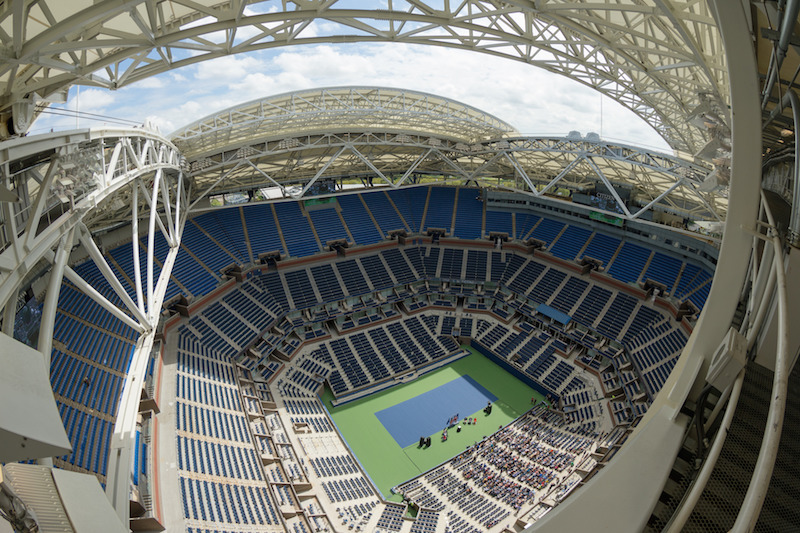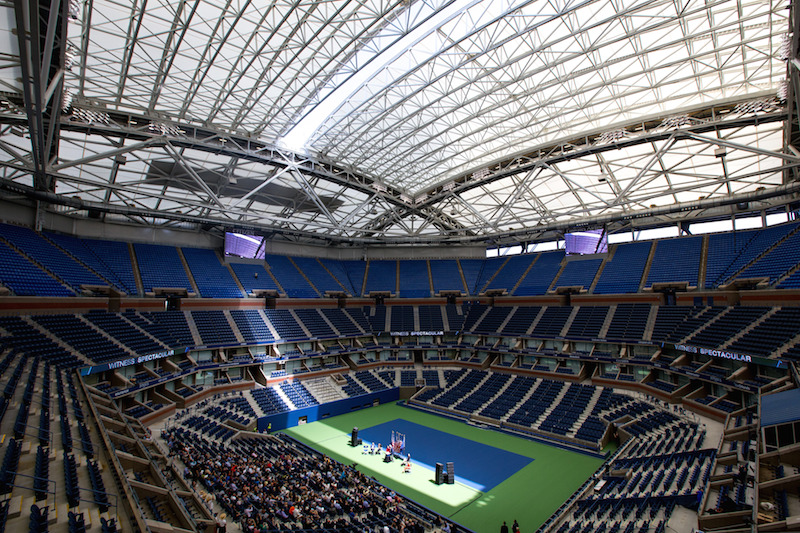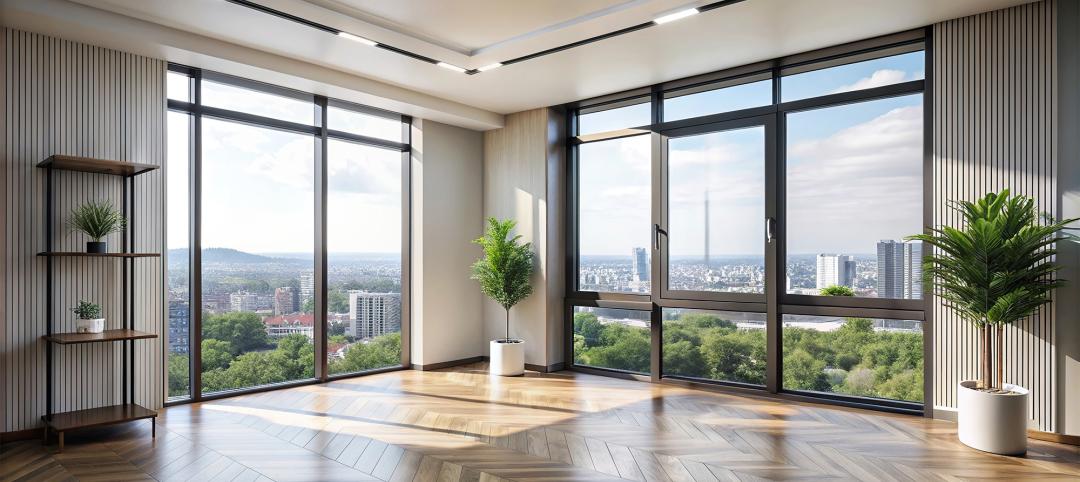As the U.S. Open Grand Slam tennis tournament in New York moves into its second week, the massive retractable roof over the 23,711-seat Arthur Ashe stadium has been drawing oohs and aahs from players and fans alike.
The $150 million roof addition is part of a $550 million renovation of the Billie Jean King National Tennis Center in Flushing, Queens. The roof itself was five years in the making, and posed several structural and engineering challenges to the Building Team, which included the architect Rossetti, the engineering firm WSP | Parsons Brinckerhoff, and the general contractor Hunt Construction Group.
This morning, BD+C interviewed WSP | Parsons Brinckerhoff execs Ahmad Rahimian, P.E., SE, F.ASCE, director of Building Structures; and Yoram Eilon, P.E., Senior Vice President of Building Structures, about this project.
Rahimian noted that any stadium construction or renovation is complicated. This one, though, was unique in several ways. For one thing, there was no precedent to draw upon in the tennis world, as Arthur Ashe is by far the largest stadium on the tour. And that facility, which opened in August 1977, wasn’t designed to include a roof.
Rahimian said that the U.S. Tennis Association (USTA), which owns and operates the venue and annual event, actually started thinking about a roof three years after the stadium opened. Those plans became more urgent in 2008, when rain interfered with the completion of some matches. Since then, rain has been a perennial threat, and occasional impediment, to the tournament’s scheduling. Design discussions for a roof began around 2011, he said.
Given the stadium’s age and structural condition, the Building Team concluded that the best solution would be to build a freestanding structure for the retractable roof that doesn’t touch the stadium itself. (There’s a 15-inch gap between the stadium and the roof pavilion.)
That roof structure sits on eight super-steel columns and 16 great brace angles that rise 125 feet above ground level, and support an 80-foot-high Teflon-covered membrane and two 500-ton panels that move back and forth over a 62,500-sf opening.
The retractable panels move on wheel assemblies mounted on rails, and can be opened or closed by cables and winches in only seven minutes.
The National Tennis Center is located in a marshy part of Queens, so the Building Team had to find answers to soil issues in order to support a roof pavilion that would weigh 6,500 tons. The steel columns are organized in an octagonal pattern that corresponds to the shape of the stadium. Each column is mounted on a concrete pier that spreads the weight load of the pavilion onto an underground concrete slab. That platform is supported by pilings that go as deeply as 180 feet into the ground.
Eilon noted, though, that this wasn’t a simple drilling job, as there are massive amounts of utilities infrastructure underground that needed to be circumvented or rerouted, not to mention the subway and Long Island Railroad systems nearby.
In addition, construction shut down during the two weeks of the tournament, which meant that cranes had to be taken down or relocated.
(Despite New York’s reputation for being a difficult place to get construction done, Rahimiam and Eilon said the city wasn’t at all intrusive. “I think they understood the significance of this to the city,” says Eilon.)

Even when the roof is open, 60% of the stadium's 23,771 seats are shaded. Image: USTA/Jennifer Pottheiser
Even when the roof is open, at least 60% of the stadium seats are shaded. To mitigate condensation and to ventilate the stadium when the roof is closed, the Building Team installed 16 air diffusers along a six-foot-wide duct that encompasses the top of the stadium, the WSP execs confirmed. As cooled air drops into the bowl of the stadium, it’s expelled by mechanical fans.
Rahimian and Eilon say that despite all this HVAC equipment, the stadium is relatively quiet when the roof is closed, although that enclosure does tends the magnify ambient sounds from the audience, which at the U.S. Open are pretty noticeable to begin with.
USTA had budgeted about $100 million for the roof project, but dealing with structural support, condensation, and ventilation tacked on another $50 million to the price tag, says Rahimian.
WSP | Parsons Brinckerhoff is involved in other facets of the National Tennis Center’s renovation, which will include an expanded Grandstand stadium. Whether other sports stadiums embrace retractable roofs, though, remains to be seen. Roland Garros, the location of the French Open in Paris, intends to install a retractable roof to cover its Court Philippe Chatrier, although construction has been pushed back to 2020 at the earliest, according to Tennis Magazine.
Rahimian believes retractable roofs help venues to “justify” their brands, and he expects more projects like these in the future. “I think it’s a trend.”
Related Stories
Multifamily Housing | Jun 14, 2024
AEC inspections are the key to financially viable office to residential adaptive reuse projects
About a year ago our industry was abuzz with an idea that seemed like a one-shot miracle cure for both the shockingly high rate of office vacancies and the worsening housing shortage. The seemingly simple idea of converting empty office buildings to multifamily residential seemed like an easy and elegant solution. However, in the intervening months we’ve seen only a handful of these conversions, despite near universal enthusiasm for the concept.
Healthcare Facilities | Jun 13, 2024
Top 10 trends in the hospital facilities market
BD+C evaluated more than a dozen of the nation's most prominent hospital construction projects to identify trends that are driving hospital design and construction in the $67 billion healthcare sector. Here’s what we found.
Adaptive Reuse | Jun 13, 2024
4 ways to transform old buildings into modern assets
As cities grow, their office inventories remain largely stagnant. Yet despite changes to the market—including the impact of hybrid work—opportunities still exist. Enter: “Midlife Metamorphosis.”
Affordable Housing | Jun 12, 2024
Studio Libeskind designs 190 affordable housing apartments for seniors
In Brooklyn, New York, the recently opened Atrium at Sumner offers 132,418 sf of affordable housing for seniors. The $132 million project includes 190 apartments—132 of them available to senior households earning below or at 50% of the area median income and 57 units available to formerly homeless seniors.
Mass Timber | Jun 10, 2024
5 hidden benefits of mass timber design
Mass timber is a materials and design approach that holds immense potential to transform the future of the commercial building industry, as well as our environment.
Lighting | Jun 10, 2024
LEDs were nearly half of the installed base of lighting products in the U.S. in 2020
Federal government research shows a huge leap in the penetration of LEDs in the lighting market from 2010 to 2020. In 2010 and 2015, LED installations represented 1% and 8% of overall lighting inventory, respectively.
Industrial Facilities | Jun 8, 2024
8 ways to cool a factory
Whichever way you look at it—from a workplace wellness point of view or from a competing for talent angle—there are good reasons to explore options for climate control in the factory workplace.
Education Facilities | Jun 6, 2024
Studio Gang designs agricultural education center for the New York City Housing Authority
Earlier this month, the City of New York broke ground on the new $18.2 million Marlboro Agricultural Education Center (MAEC) at the New York City Housing Authority’s Marlboro Houses in Brooklyn. In line with the mission of its nonprofit operator, The Campaign Against Hunger, MAEC aims to strengthen food autonomy and security in underserved neighborhoods. MAEC will provide Marlboro Houses with diverse, community-oriented programs.
Office Buildings | Jun 6, 2024
HOK presents neurodiversity research and design guidelines at SXSW 2024
Workplace experts share insights on designing inclusive spaces that cater to diverse sensory processing needs.
Apartments | Jun 4, 2024
Apartment sizes on the rise after decade-long shrinking trend
The average size of new apartments in the U.S. saw substantial growth in 2023, bouncing back to 916 sf after a steep decline the previous year. That is according to a recent RentCafe market insight report released this month.

















